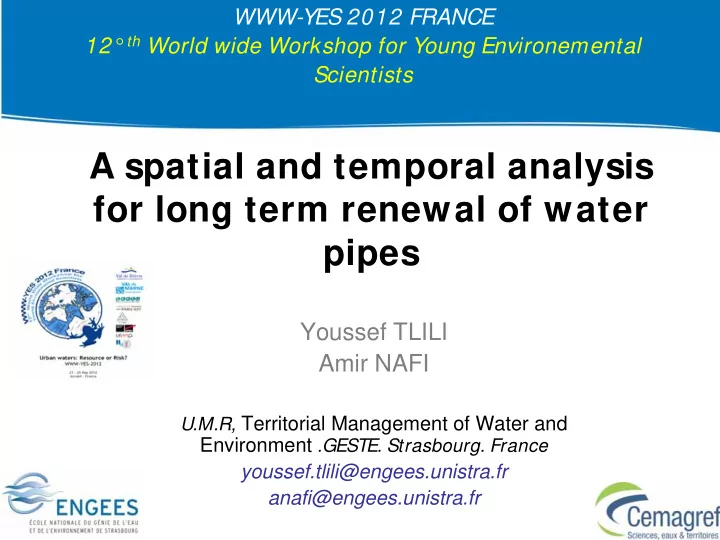

WWW-YES 2012 FRANCE 12° th World wide Workshop for Young Environemental Scientists A spatial and temporal analysis for long term renewal of water pipes Youssef TLILI Amir NAFI U.M.R, Territorial Management of Water and Environment .GESTE. Strasbourg. France youssef.tlili@engees.unistra.fr anafi@engees.unistra.fr
PRI ORI TI ZATI ON CRI TERI A (Utilnets, Caree-W Le Gauffre and Haidar, (2008) , Kanew, Riva, Sirocco, Prams, Water Gems, Nafi and Werey, (2009), Dridi et al, (2006), Halfawy et al, (2008) and Giustolisi and Berardi, (2009))
WHAT’S CLUSTERI NG? WHAT’S CLUSTERI NG? • Process of creating data collection : • Similar within the same group • Dissimilar when they belong to different groups. • Clustering is the unsupervised classification: without previously predefined classes. What’s a good clustering? • Ensures a high similarity «within-group» • Allows dissimilarity ”inter-group.”
CLUSTERI NG ALGORI THM CLUSTERI NG ALGORI THM • 1) p ∈ VEps(q) 1. Identifies groups of incidents that are spatially close • 2) |VEps (q)| >= MinPts 2. It is a hierarchical clustering routine that clusters points together on the basis of a criterion called a threshold distance 1. determined by random distance algorithm or used defined p MinPts = 5 2. Minimum number of events may also be q Eps = 1 defined 3. Clustering is repeated until either all points are grouped or the clustering routine fails
CLUSTERI NG ALGORI THM CLUSTERI NG ALGORI THM Bottom-up detection approaches Detection failure when • Select p (basic break point) 1. Find individual data points there is no a significant with “interesting” local • Detect all break points accessible density in a certain neighborhoods neighborhood. from p respectively Eps et MinPts. 2. Aggregate interesting • If p is a center, a cluster is formed. points into clusters. • If p is a limit, there is no accessible break point from p, move to another point. • Repeat the same processus until all all break points are grouped (clustered).
HOW BREAKS ARE – THEY DI STRI BUTED I N A HOW BREAKS ARE – THEY DI STRI BUTED I N A WDN ? WDN ?
NEAREST NEI GHBOR I NDEX (NNI ) NEAREST NEI GHBOR I NDEX (NNI ) n ∑ NND N N D = = = i 1 NNI N N D N N D n R 1 n = = N N D Density R 2 A Density • n is the number of failures. • A is the size of the analyzed area, • NNI the ratio of the observed distance to the expected distance (Nearest neighbour index) • NND is the distance between each failure location and its nearest neighbour. : the observed mean distance between nearest neighbours NND :the expected value of the nearest neighbour distance in a random pattern. NND R
NEAREST NEI GHBOR I NDEX (NNI ) NEAREST NEI GHBOR I NDEX (NNI )
SPATI AL ANALYSI S SPATI AL ANALYSI S Fig.1. Case study
HOTSPOT ANALYSI S HOTSPOT ANALYSI S Fig.2. Analysis
HOTSPOT ANALYSI S HOTSPOT ANALYSI S Fig.3. Merged clusters
Fig.5. Hotspot analysis: Kernel density estimation.
HOTSPOT ANALYSI S HOTSPOT ANALYSI S Fig.5. Breakage rate/cluster
RESULTS RESULTS Fig.5. Avoided breaks
THANKS FOR YOUR ATTENTI ON
Does the clustering is a pertinent criterion for water pipe prioritization for replacement? Yes!!! Cluster 1 , n breaks, density m, … Cluster 2, ………………………. … Cluster 3,……………………….. ... Cluster N………………………….… “What am I supposed Huge mass of data Detection algorithm Other criteria to do with this?” Multi-criteria decision making for prioritizing water pipes How to aggregate all criteria to get Which weights? a final ranking? Which methods?
Criteria, j unit Assessment function, g j () Breakage rate #/km/year Number of pipe breaks (failures) during an observation window [ t a , t b ] divided by the pipe length and by the duration of the observation window m 3 Demand The peak period demand identified along the pipe (or at both sides of pipe, if we assume that demand is gathered in nodes) Hydraulic capacity / Expresses the physical condition of the pipe section. It is described by the Hazen-Williams coefficient Residual lifetime Year (s) Evaluate the end of service life of a pipe according to a theoretical lifetime which can be either the average and technical lifetime duration or the accounting lifetime used for the calculation of the depreciation. The residual lifetime is expressed as the proportion of the remaining service lifetime of a pipe compared to a theoretical service life. We recommend differentiating between the theoretical lifetime based on the nature of material and pipe diameter. Belonging to a loop or / Evaluate the pipe role on the water supply and the impact of a random event on the service reliability. Indeed, if a branch pipe is in a loop, its failure will affect less the water supply than another in a branch or the network extremities. Material / According to the decision makers, the material with which a pipe is made, constitutes a renewal criterion. The analysis of the failure history allows determining the most vulnerable materials and therefore offers a first ranking according to the type of material. Clustering #/cluster/year The belonging of a pipe to a cluster is used as a renewal criterion. In addition, the ranking of a pipe candidate for renewal will be based on the breakage rate of the cluster to which it belongs Diameter mm The pipe diameter may be a criterion of renewal; however it’s implicitly combined with the breakage rate. Usually large diameters fail less than smaller ones.
Recommend
More recommend